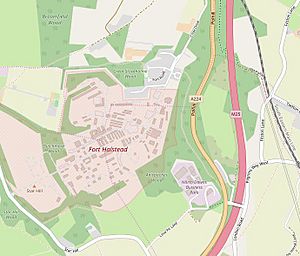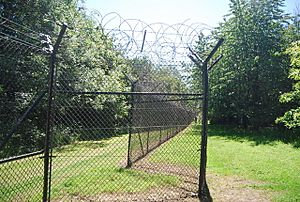Fort Halstead facts for kids
Fort Halstead is a secret research site run by Dstl, which is a part of the UK Ministry of Defence. It sits high up on the Kentish North Downs hills, looking down at the town of Sevenoaks, southeast of London. This fort was first built in 1892 as one of many forts around London. Its original job was to be ready for volunteers to defend the city if there was a crisis.
Later, this base became home to the Projectile Development Establishment. It also housed the Ministry of Supply and was the main office for the Royal Armament Research and Development Establishment (RARDE).
Contents
Building a Fort to Protect London
Fort Halstead was part of a bigger plan called the London Defence Positions. This idea came from Lieutenant General Edward Bruce Hamley and was put into action by the Secretary of State for War, Edward Stanhope, in 1889. The plan was to dig long trenches if a war started, to protect London from the south and east.
To help with this, thirteen simple forts, called "Mobilisation Centres," were planned. These forts would store tools, supplies, and ammunition for the Volunteer Force. These volunteers were meant to dig the trenches and defend them.
In 1890, the War Office bought land for Fort Halstead on high ground near Sevenoaks. Because of money problems, the fort was built a bit later, between 1895 and 1897. It had vaulted rooms for soldiers on one side and a magazine (for storing ammunition) on the other. An earth wall with spots for light field artillery and machine guns surrounded the fort. There was also a ditch with a concrete wall. A small house was built for a caretaker to look after the fort when there wasn't a war.
Fort Halstead's Early Days
As the Royal Navy became very strong, the chance of an invasion became much smaller. So, the London Defence Scheme was officially stopped in March 1906. Many of the forts were sold, but Fort Halstead and a few others were kept.
When the First World War began, the London Defence Scheme was brought back. Many of the planned trenches were actually dug. Fort Halstead seemed to go back to its original purpose. In 1915, a lab was built inside the fort to check ammunition.
In 1921, a retired colonel bought the fort. He lived in the lab building and rented out the small houses. The rest of the site was used as a camp for the Territorial Army, Boy Scouts, and Girl Guides. It even housed refugees for a time.
Rocket Science at Fort Halstead
In 1938, Fort Halstead became home to the Projectile Development Establishment. This group continued working on solid fuelled rockets, a project that had started a couple of years earlier. Under the leadership of Dr. Alwyn Crow, scientists mainly worked on rockets that could be used as anti-aircraft weapons. To support this research, over eighty new buildings were constructed around the fort.
The work at Fort Halstead led to the creation of the 7-inch Unrotated Projectile, which was used on Royal Navy ships. They also developed a smaller 3-inch version for the British Army. These rockets were used in hundreds of Z Batteries to defend the UK from air attacks. Further developments included the RP-3 anti-tank rocket, which was fired from planes, and the Mattress and Land Mattress systems for firing many rockets from the ground.
The Royal Armament Research and Development Establishment (RARDE)
In 1922, two departments, the "Research Department" and the "Design Department," were set up. During the Second World War, both departments moved to Fort Halstead.
It's believed that Britain's development of the atomic bomb first happened at Fort Halstead. This top-secret project was hidden under the name "High Explosive Research" ("HER"). The first atomic bomb was developed here under the leadership of William George Penney. This bomb was later taken to Australia and successfully exploded in the Montebello Islands in an event called Operation Hurricane. In 1950, the "HER" research is thought to have moved to a new site at Atomic Weapons Establishment, Aldermaston.
In 1955, the two departments merged to form the Armament Research and Development Establishment (ARDE). In 1962, it was given the title "Royal," becoming RARDE. In the 1980s, RARDE joined with other military research groups, including those that worked on military vehicles and rocket motors.
Scientists from RARDE's explosives lab also helped examine evidence from important investigations. For example, after the 1988 Lockerbie incident, experts from Fort Halstead examined materials and later shared their findings in court. In 1996, the wreckage of a bus from the Aldwych bus incident was brought to Fort Halstead for analysis.
RARDE was also involved in military simulations and war games. These projects helped assess how well future defence equipment would work. For example, in 1990, computer war games were played at RARDE to prepare for Operation Granby, Britain's part in the Gulf War. In 2017, scientists from Fort Halstead also examined wreckage from a 2010 plane crash for traces of explosives, helping the Polish government.
From RARDE to Dstl
On April 1, 1991, a new agency called the Defence Research Agency (DRA) was created. It brought together several important research groups, including RARDE. This agency was part of the Ministry of Defence. Four years later, the DRA merged again to form the Defence Evaluation and Research Agency (DERA).
In 2001, DERA was split into two new organizations: QinetiQ and Dstl. Fort Halstead was kept by QinetiQ, which then leased part of the site back to Dstl. The main jobs at Fort Halstead became research, testing, and forensic analysis of explosives. The site's explosives lab was used again after the attempted 21 July 2005 London bombings to investigate. Fort Halstead used to be the biggest employer in the Sevenoaks district, with 1,300 people working there in 2000.
In March 2006, QinetiQ sold the Fort Halstead site to another company, but QinetiQ stayed on as a tenant. On June 17, 2011, Dstl announced that its facilities at Fort Halstead would close after a review. Current plans for the Fort Halstead site include building 700 new homes and a business area, which will still include QinetiQ.
Famous People Who Worked Here
Many smart and important people have worked at Fort Halstead, including:
- Richard, Baron Beeching – known for his report on British railways.
- Sir Alwyn Crow – who helped develop the Unrotated Projectile rocket.
- Dr. Douglas Hartree – a scientist known for his work in atomic energy.
- Sir John Lennard-Jones – known for his work on how atoms attract each other.
- Sir Nevill Mott – a Nobel Prize winner in Physics.
- William, Baron Penney – a key scientist in the atomic bomb project.
- Dick Strawbridge – an engineer, environmentalist, and TV presenter.



